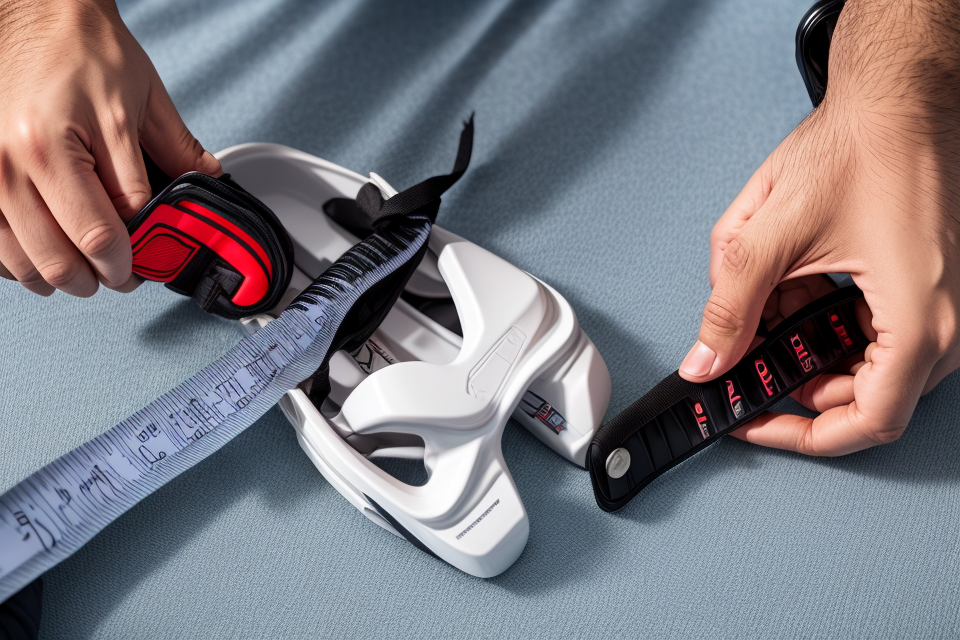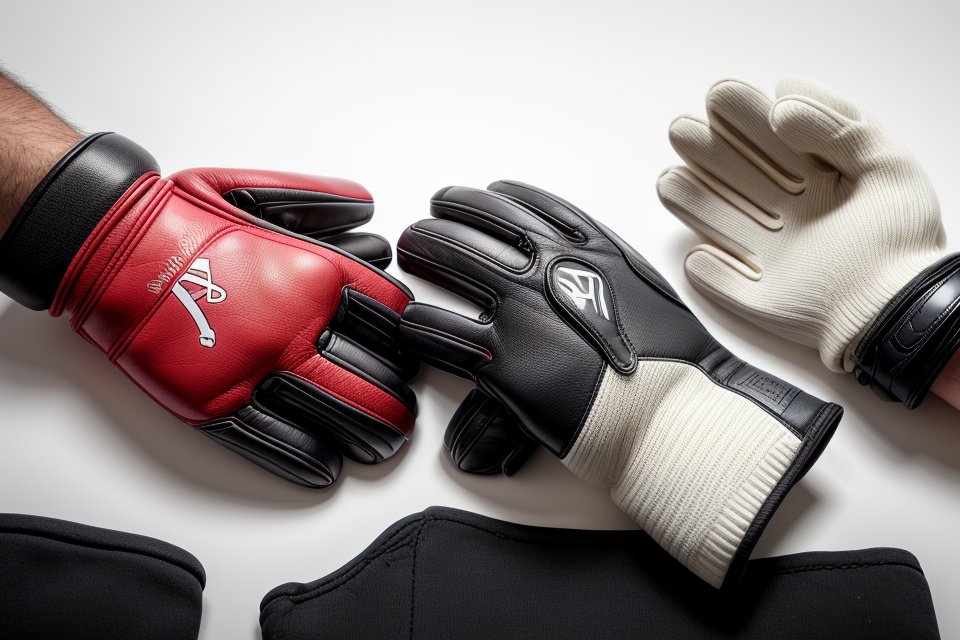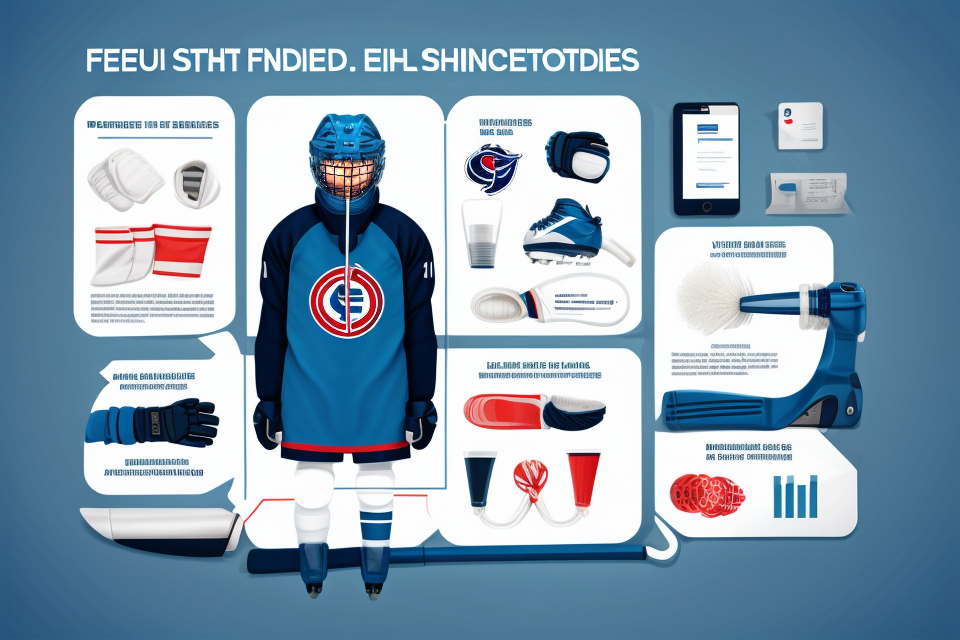Hockey is a fast-paced and physically demanding sport that requires players to have a great deal of skill and coordination. One of the most iconic pieces of equipment in hockey is the hockey glove, which is designed to provide players with maximum protection and control. However, one aspect of the hockey glove that may seem somewhat unusual is the loop on the thumb. But why is there a loop on the thumb of a hockey glove? In this article, we will explore the science behind this unique design feature and how it helps players perform at their best on the ice.
Why Hockey Players Need a Special Glove
Materials Used in Hockey Gloves
The materials used in hockey gloves are specifically chosen for their ability to provide optimal protection, flexibility, and grip. Here are some of the most common materials used in hockey gloves:
1. Leather
Leather is a common material used in hockey gloves, particularly in the palm and fingers. Leather provides excellent durability and resistance to wear and tear, which is crucial for withstanding the impact of pucks and checks during games. It also offers good grip on the stick, allowing players to maintain control during fast-paced play.
2. Foam
Foam is often used in the glove’s thumb and knuckle areas to provide a snug fit and comfortable feel. It also helps to absorb impacts and protect the hand from injuries. Some gloves may use different types of foam, such as EVA (ethylene vinyl acetate) or PE (polyethylene), depending on the desired level of protection and cushioning.
3. Kevlar
Kevlar is a lightweight, high-strength synthetic fiber that is sometimes incorporated into hockey gloves, usually in the knuckle area. Its high tensile strength and durability make it an excellent material for reinforcing the glove’s impact resistance and protecting the hand from injuries. Kevlar can also help to reduce the risk of cuts and abrasions.
4. TPR
TPR (thermoplastic rubber) is a flexible, durable material that is often used in hockey gloves for added protection and support. It can be found in the glove’s fingers, knuckles, and thumb, providing a secure fit and improved impact resistance. TPR can also help to enhance grip on the stick, which is crucial for controlling the puck during gameplay.
5. Padding
Padding is an essential component of hockey gloves, particularly in the palm and thumb areas. It provides impact protection and cushioning for the hand, which is essential for absorbing the force of hits and falls. Different types of padding may be used, such as foam, EVA, or polyurethane, depending on the desired level of protection and comfort.
6. Mesh
Mesh is often used in the glove’s backhand area to improve ventilation and reduce sweat buildup. This helps to keep the hand dry and comfortable during gameplay, which is essential for maintaining grip on the stick and overall performance. Some gloves may also feature a ventilated thumb, which can further enhance airflow and reduce hand fatigue.
By understanding the materials used in hockey gloves, players can make informed decisions when selecting the right equipment to meet their specific needs and preferences. The right combination of materials can provide optimal protection, comfort, and performance on the ice.
Finger Protection and Flexibility
Hockey is a physically demanding sport that requires players to have specialized equipment to protect them from injuries. One such piece of equipment is the hockey glove, which is designed to provide protection to the fingers while allowing for flexibility and mobility.
The thumb is an essential part of the hand that is crucial for proper finger movement and grip. However, it is also the most vulnerable part of the hand, as it is prone to injuries such as sprains and fractures. This is why hockey players need a special glove that provides additional protection to the thumb.
The loop on the thumb of a hockey glove is a crucial component that serves two purposes. Firstly, it provides additional protection to the thumb by keeping it in place and preventing it from getting injured. Secondly, it allows for greater flexibility and mobility of the thumb, which is essential for proper finger movement and grip.
The loop is typically made of a soft, flexible material such as leather or synthetic fabric. This material allows for the thumb to move freely while still providing support and protection. The loop is also designed to be adjustable, which allows players to customize the fit of the glove to their hand.
In addition to providing protection and flexibility, the loop on the thumb of a hockey glove also helps to reduce the risk of injuries to the wrist and forearm. By keeping the thumb in place, the loop helps to stabilize the hand and prevent it from twisting or bending in ways that can cause injuries.
Overall, the loop on the thumb of a hockey glove is an essential component that provides protection, flexibility, and support to the hand. It is a crucial piece of equipment that helps hockey players perform at their best and avoid injuries on the ice.
The Importance of the Thumb
The Thumb in Hockey
The thumb is a crucial part of a hockey player’s equipment as it helps them control the stick and take accurate shots. The loop on the thumb of a hockey glove is designed to provide additional support and protection to the thumb while also allowing for greater flexibility and control.
In hockey, the thumb plays a vital role in the mechanics of shooting and passing the puck. The thumb is responsible for controlling the blade of the stick, which is used to hit the puck. A strong and stable thumb is essential for accuracy and power in shots.
Furthermore, the thumb is also used to grip the handle of the stick, which is crucial for maintaining control during quick movements and changes in direction. Without a strong grip, a player’s control over the stick and their ability to make quick movements would be greatly diminished.
In addition to its role in shooting and passing, the thumb is also important for protecting the hand and wrist from impacts and injuries. The loop on the thumb of a hockey glove provides an extra layer of protection for the thumb, helping to absorb impacts and prevent injuries.
Overall, the thumb is a critical component of a hockey player’s equipment, and the loop on the thumb of a hockey glove is an important feature that helps provide support, protection, and control.
The Thumb Loop
The thumb loop is a crucial component of a hockey glove that plays a significant role in enhancing the overall performance of a player. It is designed to provide extra support and stability to the thumb, which is essential for accurate shooting, precise puck handling, and efficient stick control.
One of the primary functions of the thumb loop is to keep the thumb in a proper position during gameplay. It prevents the thumb from bending excessively, which can cause a loss of control over the stick and hinder the player’s ability to make accurate shots. The loop also helps in maintaining a firm grip on the stick, enabling players to control the puck more effectively.
Another advantage of the thumb loop is that it provides additional protection to the thumb. The loop is usually made of a durable material that can withstand the impact of pucks and sticks, reducing the risk of injuries to the thumb. This feature is particularly important for players who engage in physical play or are prone to collisions on the ice.
Moreover, the thumb loop also plays a role in enhancing the overall fit and comfort of the hockey glove. It helps to keep the glove securely in place on the hand, preventing it from slipping or moving around during gameplay. This feature is especially important for players who prefer a snug fit in their gloves, as it allows them to maintain a firm grip on their stick without any distractions.
Overall, the thumb loop is a critical design feature of a hockey glove that contributes significantly to a player’s performance on the ice. It provides extra support and stability to the thumb, enhances grip and control over the stick, and offers additional protection to the thumb. As a result, it has become an essential component of modern hockey equipment, and many players consider it to be a must-have feature in their hockey gloves.
How the Loop Works
Anatomy of the Thumb Loop
The thumb loop is a crucial component of a hockey glove that plays a vital role in enhancing the performance of players. It is a padded area located at the base of the thumb, designed to provide extra protection and support to the thumb joint.
The thumb loop is made up of several layers of material, including foam and felt, which work together to provide a comfortable and secure fit. The foam layer is placed between the thumb and the rest of the glove, while the felt layer is attached to the outer surface of the glove.
The thumb loop is also designed to be adjustable, allowing players to customize the fit of their glove to their liking. This is achieved through the use of Velcro straps or laces, which can be tightened or loosened to provide a snug fit around the thumb.
Overall, the anatomy of the thumb loop in a hockey glove is carefully designed to provide optimal protection and support to the thumb joint, while also allowing for a customizable fit that can be adjusted to suit the individual needs of each player.
Advantages of the Loop
Improved Control and Precision
The loop on the thumb of a hockey glove offers several advantages to players, the most significant of which is improved control and precision. The loop allows for a more secure grip on the stick, reducing the risk of the stick slipping out of the player’s hand during gameplay. This increased control translates to improved accuracy when shooting and passing the puck, giving players an edge over their opponents.
Reduced Fatigue and Injury Risk
Another advantage of the loop is that it helps to reduce fatigue and injury risk. The loop allows for a more comfortable grip on the stick, reducing the strain on the player’s hand and wrist. This, in turn, reduces the risk of developing hand and wrist injuries, which are common among hockey players. Additionally, the loop helps to keep the player’s hand in a more natural position, reducing the risk of developing carpal tunnel syndrome or other repetitive strain injuries.
Customization and Comfort
The loop on the thumb of a hockey glove also offers customization and comfort benefits. Many hockey gloves come with adjustable loops, allowing players to customize the fit of the glove to their hand size and preferences. This customization ensures that the glove fits snugly and comfortably, reducing the risk of it coming loose during gameplay. Additionally, the loop is often made of a soft, breathable material, which helps to keep the player’s hand dry and comfortable throughout the game.
Overall, the loop on the thumb of a hockey glove offers several advantages to players, including improved control and precision, reduced fatigue and injury risk, and customization and comfort benefits. These advantages make the loop an essential component of modern hockey equipment, and it has become a standard feature on most hockey gloves.
The History of the Thumb Loop
Early Hockey Gloves
The history of the thumb loop in hockey gloves can be traced back to the early days of hockey. In the late 1800s and early 1900s, hockey players did not wear gloves at all. Instead, they would often wear regular gloves or mittens to protect their hands during games.
As the sport evolved, so did the equipment. In the 1920s and 1930s, hockey gloves began to be designed specifically for the sport. These early gloves were made of leather and had a simple design with no thumb loop.
It wasn’t until the 1950s that the thumb loop became a standard feature in hockey gloves. The loop was added to help players grip their sticks more securely and to prevent their thumbs from slipping out of the glove during play.
The thumb loop has since become an essential part of the hockey glove, and its design has evolved over the years to meet the changing needs of players. Today’s hockey gloves feature a variety of thumb loop designs, including the traditional loop, the closed loop, and the open loop, each with its own unique benefits.
Evolution of the Thumb Loop
The thumb loop, a small but crucial design feature on a hockey glove, has undergone several significant changes over the years. It was first introduced in the early 1960s as a means to provide extra support for the thumb, which was prone to injuries in players. Since then, the thumb loop has evolved significantly, becoming a standard feature on most hockey gloves.
One of the most significant changes in the evolution of the thumb loop was in the 1970s, when it was made larger and more padded. This change was made in response to the increasing speed and power of hockey players, who were putting more strain on their equipment. The larger and more padded thumb loop provided extra support for the thumb, reducing the risk of injury.
Another significant change in the evolution of the thumb loop was in the 1990s, when it was redesigned to be more flexible and lightweight. This change was made in response to the increasing skill and agility of hockey players, who were looking for equipment that was more comfortable and allowed for greater mobility. The new design of the thumb loop allowed for greater range of motion in the hand, while still providing adequate support for the thumb.
In recent years, the thumb loop has continued to evolve, with manufacturers experimenting with new materials and designs. Some gloves now feature a thumb loop made of a stretchy, breathable material, which provides support while also allowing for greater comfort and flexibility. Other gloves feature a thumb loop that is attached to the glove with a hook and loop fastener, which allows for easy adjustment and a customized fit.
Overall, the evolution of the thumb loop on a hockey glove reflects the changing needs and preferences of hockey players over the years. As the game has become faster and more physically demanding, equipment designers have worked to create gloves that provide greater support and protection, while also allowing for greater mobility and comfort.
Popular Brands with Thumb Loops
Comparing Features
When it comes to hockey gloves with thumb loops, there are several popular brands available in the market. It is essential to compare the features of these brands to determine which one is the best fit for your needs. Here are some of the key factors to consider when comparing different brands of hockey gloves with thumb loops:
- Material: The material used to make the glove is an essential factor to consider. Some gloves are made from synthetic materials, while others are made from leather. Synthetic materials are generally lighter and more flexible, while leather gloves are more durable and provide better protection.
- Fit: The fit of the glove is crucial for optimal performance. A glove that is too loose or too tight can hinder your ability to grip the stick and control the puck. Make sure to try on different sizes and brands to find the perfect fit.
- Thumb Loop Design: The design of the thumb loop can vary from brand to brand. Some gloves have a simple loop that can be easily adjusted, while others have a more complex design that provides more support and stability. Consider your personal preferences and playing style when choosing a glove with a thumb loop.
- Additional Features: Some gloves come with additional features, such as ventilation systems or reinforced palms. These features can enhance your performance and comfort during gameplay. Consider whether these features are essential for your needs and whether they are worth the extra cost.
- Price: Hockey gloves with thumb loops can vary in price depending on the brand, material, and additional features. Set a budget before purchasing a new glove and compare different options to find the best value for your money.
By considering these factors, you can make an informed decision when choosing a hockey glove with a thumb loop. Remember that the right glove can make a significant difference in your performance on the ice, so take the time to find the best fit for your needs.
Choosing the Right Glove
When it comes to choosing the right hockey glove with a thumb loop, there are several factors to consider. First and foremost, it’s important to choose a glove that fits your hand comfortably and provides adequate protection. The thumb loop should be adjustable to ensure a snug fit and prevent the glove from slipping during gameplay.
In addition to fit and protection, you may also want to consider the brand of the glove. Some of the most popular brands that offer gloves with thumb loops include CCM, Bauer, and Easton. Each brand has its own unique features and benefits, so it’s important to do your research and choose the one that best suits your needs.
Another factor to consider is the position you play on the ice. For example, a defenseman may require a different type of glove than a forward. Defensemen typically need a glove that provides more protection for the blocker side of the hand, while forwards may prefer a glove that allows for more dexterity and control of the stick.
Ultimately, choosing the right hockey glove with a thumb loop comes down to personal preference and the specific needs of the player. It’s important to try on several different options before making a decision to ensure that you find the perfect fit for your hand and playing style.
The Future of Hockey Gloves
Advancements in Materials and Design
One of the most significant advancements in hockey gloves is the use of cutting-edge materials and designs. As technology continues to evolve, manufacturers are constantly exploring new ways to improve the performance of their products.
Increased Focus on Fit and Comfort
Another trend in the future of hockey gloves is a greater emphasis on fit and comfort. Many players have different hand sizes and shapes, and a poorly fitting glove can hinder performance. As a result, manufacturers are developing gloves with more customizable fit systems, such as adjustable closures and different sizes of fingers.
Enhanced Protection and Durability
As the game of hockey becomes increasingly physical, there is a growing demand for gloves that offer enhanced protection and durability. Manufacturers are responding to this demand by incorporating new materials and designs that provide greater resistance to impact and abrasion.
Integration of Technology
The integration of technology is another area where hockey gloves are expected to see significant advancements in the future. Manufacturers are exploring the use of sensors and other devices to track and analyze various aspects of a player’s performance, such as stick handling, shooting, and passing. This data can then be used to help players improve their skills and coaches make more informed decisions.
Environmental Sustainability
As environmental concerns continue to grow, there is a greater focus on sustainability in the design and production of hockey gloves. Manufacturers are exploring ways to reduce their environmental impact by using eco-friendly materials and implementing sustainable production practices.
In conclusion, the future of hockey gloves is likely to be characterized by advancements in materials and design, increased focus on fit and comfort, enhanced protection and durability, integration of technology, and environmental sustainability. As the game continues to evolve, these trends are expected to shape the development of hockey gloves for years to come.
Stay Safe and Play Well
One of the main advantages of a thumb loop in a hockey glove is the added protection it provides to the thumb. Many popular brands of hockey gloves, such as CCM, Bauer, and Easton, feature thumb loops in their top models. This is because the thumb loop helps to prevent injuries to the thumb, which is a common area for impact during a game.
When a player is holding their stick and is hit by a puck or a opponent’s body check, the thumb is vulnerable to injury. The thumb loop helps to keep the thumb in place and prevents it from being bent back or twisted, which can cause sprains or fractures.
In addition to providing protection, the thumb loop also allows for better control of the stick. By keeping the thumb in a stable position, the player is able to maintain a firm grip on their stick and make quick movements, which is essential in a fast-paced game like hockey.
Overall, the thumb loop is an important feature in a hockey glove that helps to keep the thumb safe and allows for better control of the stick.
FAQs
1. What is the loop on the thumb of a hockey glove called?
The loop on the thumb of a hockey glove is commonly referred to as the “thumb loop” or “thumb catch”. It is a small piece of material, usually made of synthetic fibers, that is attached to the thumb of the glove and forms a loop.
2. Why is there a loop on the thumb of a hockey glove?
The loop on the thumb of a hockey glove serves a few important purposes. Firstly, it helps to keep the thumb in place and prevent it from slipping out of the glove during play. This is particularly important for goaltenders who need to make quick and precise movements with their hands.
Secondly, the thumb loop helps to maintain the structural integrity of the glove. It provides an additional point of support and prevents the thumb from bending or twisting in ways that could compromise the glove’s protection.
Finally, the thumb loop can also serve as a stylistic feature, adding to the overall aesthetic of the glove.
3. Is the loop on the thumb of a hockey glove necessary?
While the loop on the thumb of a hockey glove is not strictly necessary for playing the game, it can be an important feature for goaltenders who rely on the glove for protection and support. The loop helps to keep the thumb in place and maintain the structural integrity of the glove, which can be crucial in high-pressure situations.
That being said, some players may prefer gloves without a thumb loop for a more comfortable fit or a sleeker look. Ultimately, the decision to include or exclude the loop on the thumb of a hockey glove comes down to personal preference and playing style.
4. Can the loop on the thumb of a hockey glove be adjusted or removed?
In some cases, the loop on the thumb of a hockey glove can be adjusted or removed. For example, some gloves may have adjustable velcro straps or laces that can be tightened or loosened to accommodate different hand sizes or preferences.
In other cases, the loop may be removable, either through a zipper or by untying a string. This can be useful for players who prefer a more minimalist glove or who want to customize the fit and feel of their glove.
However, it’s important to note that removing or adjusting the loop on the thumb of a hockey glove can potentially compromise the glove’s structural integrity and protection. If you’re considering making any modifications to your glove, it’s best to consult with a professional or experienced player to ensure that you’re not sacrificing performance for style.



